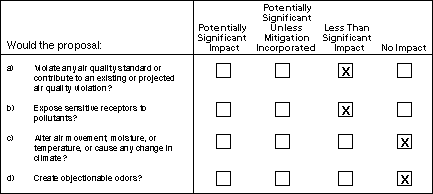
V. AIR QUALITY

The proposed project is located within the southern portion of the San Francisco Bay Area Air Basin and lies within the jurisdiction of the Bay Area Air Quality Management District (BAAQMD).
Construction activities would temporarily increase particulate concentrations in and around the project sites. The impact would be temporary and would last for the duration of the project construction. Approximately one mile of transmission line would be constructed underground from PG&E’s property boundary near Monta Vista substation to the end of Groveland Drive. Installation of the underground cable would require excavation and disposal of approximately 5,000 cubic yards of asphalt and spoil. Construction equipment and vehicles would generate dust during clearing and excavation and produce minor short-term emissions from vehicles and construction machinery. Underground construction would require approximately 10 to 20 crew members to commute to the project site and last for a duration of four months. Boring of the five pole foundation holes required for the transmission line from the Monta Vista substation to the underground line would be a minor source of dust emissions. Construction activities associated with reconductoring the transmission line between the SCVWD property and the Wolfe and Stelling substations would generate negligible emissions. Particulate concentrations that would occur at or adjacent to the construction sites would be affected by local wind conditions and vegetation and by variations in soil, silt, and moisture content.
BAAQMD considers construction emissions to be significant only if project-appropriate mitigation measures are not implemented. Dust is comprised of large particles (i.e., larger than 10 microns in diameter) which settle out rapidly on nearby horizontal surfaces and are easily filtered by human breathing passages. Much of the dust generated by construction is therefore of concern more as a soiling nuisance rather than for its unhealthful impacts. The remaining fraction of small particulate matter might be sufficient to violate the state 24-hour average PM-10 standard in the vicinity of construction. Unless mitigation measures are implemented, elevated levels of PM-10 would occur throughout periods of project construction. PG&E has committed to mitigation measures, provided at the end of this section, to comply with the BAAQMD CEQA Guidelines to reduce construction impacts to a less than significant level.
Long term operation of the proposed facilities at the Monta Vista substation and underground/overhead transmission lines would generate no direct air emissions and would not result in an increase in vehicle trips to the sites. The project would not cause or contribute to a violation of any federal, state, or local air quality standards.
The proposed project would allow for the delivery of electricity that would otherwise not be transmitted. Much of California's electricity is generated by fossil fuels, the combustion of which results in air pollutant emissions at power plants. It is assumed that the existing sites operate within air emission caps created by the local air districts. The project itself would not induce demand for generation of additional electricity.
Construction dust emissions primarily from excavation and disposal activities could have a temporary impact on the Foothill Christian Center/Monarch Christian School, which is located adjacent to the proposed underground line along Foothill Boulevard. Very young children or the infirm could be considered sensitive receptors. Residents in the neighborhoods along Salem Avenue, Foothill Boulevard, and Creston Drive also may be exposed to dust emissions from construction of the proposed underground line. The impact to the congregation, school, and residents would likely be a nuisance impact related to larger particle dust settling out and would not violate PM-10 standards. With implementation of the above-cited mitigation measures, this impact would be less than significant. Similarly, dust could be a nuisance for construction of the transmission lines and other facilities. Project operations would not have a long-term impact to local air pollutant concentrations because substation equipment and transmission lines are not sources of air emissions.
The proposed project would not be a source of thermal emissions and would not represent the type of operation that could cause alteration of air movement, moisture, or temperature, or cause any change in climate. Therefore, there would be no impacts related to climate change.
The proposed Monta Vista substation equipment and transmission lines are not the type of operation identified by BAAQMD as a typical odor source (BAAQMD, 1996). The project would not result in an odor-related impact. Excavated saturated muds sometimes are regarded as a source of objectionable odor; however, if any were encountered during construction the effect would be a relatively brief nuisance odor, and would be eliminated when fill is placed over the excavated mud.
Applicant Proposed Mitigation
The following mitigation measures proposed by PG&E would ensure that all impacts to air quality resulting from the project would be less than significant:
Although short-term construction vehicle emissions would be minimal relative to the ambient emission levels, the following mitigation measures have been incorporated into the project by PG&E to further reduce emissions during construction activities:
TOP
| Forward to Next Section (Transportation and Circulation) |
Back to Previous Section (Water) |
Back to Monta Vista/Wolfe/Stelling Looping Project Main Page | CPUC Environmental Page | CPUC Home Page |